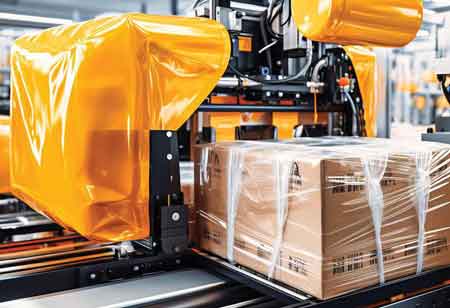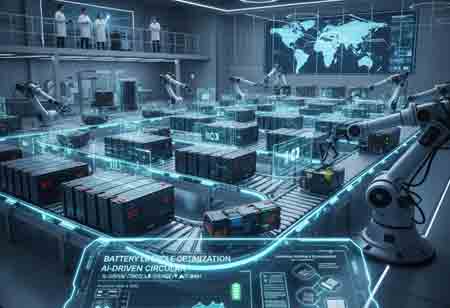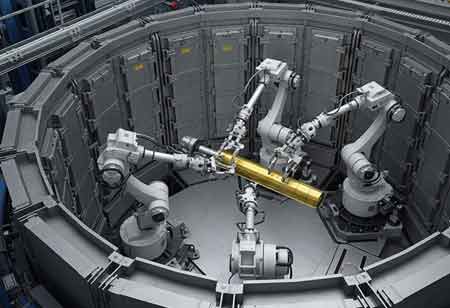CLOSE
Specials
I agree We use cookies on this website to enhance your user experience. By clicking any link on this page you are giving your consent for us to set cookies. More info
Be first to read the latest tech news, Industry Leader's Insights, and CIO interviews of medium and large enterprises exclusively from Energy Tech Review
Thank you for Subscribing
The Role of Advanced Heating Solutions in Canada's Industrial Sector
The industrial heater manufacturing sector in Canada's energy technology landscape is propelled by factors prioritizing efficiency, environmental stewardship, and technological advancement.

By
Energy Tech Review | Wednesday, September 03, 2025
Stay ahead of the industry with exclusive feature stories on the top companies, expert insights and the latest news delivered straight to your inbox. Subscribe today.
The industrial heater manufacturing sector in Canada's energy technology landscape is propelled by factors prioritizing efficiency, environmental stewardship, and technological advancement. The role of cutting-edge technology in this transformation, particularly in enhancing efficiency, is significant and inspiring, as it opens up new possibilities and solutions.
Market Dynamics and Growth Trajectories
The Canadian industrial heating equipment market is not just growing, but it's also a promising field for potential profit. Projections indicate a robust expansion in the coming years, driven by the country's ongoing industrial activities and the imperative for modernization across various sectors. This includes manufacturing, oil and gas, chemical processing, food and beverage, and pulp and paper. While Canada's overall heating equipment market is substantial, specific segments within industrial heating, such as furnaces and boilers, are seeing significant evolution, presenting a wealth of opportunities for investors.
One significant trend is the increasing adoption of electric heating solutions. This shift is not just about energy efficiency, but also about a growing awareness of environmental concerns. The compatibility of electric heaters with renewable energy sources further amplifies their appeal, aligning with broader sustainability goals. For instance, the industrial furnace market in Canada is projected to witness a compound annual growth rate of over 5 percent from 2025 to 2030, with electric arc furnaces identified as a significant revenue-generating segment. This signifies a clear move towards cleaner and more sustainable heating methods.
It's not just about new installations; the retrofit market is also a crucial player in modernizing the Canadian industrial heating market. Aging industrial infrastructure necessitates upgrades to comply with modern efficiency standards and reduce operational costs and environmental footprints. This ongoing demand for system modernization, particularly in the retrofit market, provides a consistent impetus for manufacturers to develop and deploy advanced heating solutions.
Technological Innovations Driving Efficiency and Sustainability
Innovation is at the core of the Canadian industrial heater manufacturing industry, particularly as it navigates the transition to a lower-carbon economy. The focus is on developing technologies that provide adequate heat and minimize energy waste and greenhouse gas emissions. One of the most impactful innovations is the growing integration of smart technology and the Internet of Things (IoT) into industrial heating systems. IoT-enabled devices facilitate real-time monitoring of boiler and furnace performance and play a crucial role in optimizing energy management. This, coupled with the further enhancement by Artificial Intelligence (AI), which analyzes sensor data to predict potential failures and dynamically optimize system settings for maximum efficiency, ensures that the audience is well-informed about the latest technological advancements in the industry.
Heat pumps are not just emerging but transforming the industrial heating landscape, particularly for medium and low-temperature applications. Their ability to recover and reuse low-grade heat and their inherent energy efficiency make them a compelling alternative to traditional fossil fuel-based systems. The heat pump-based industrial heating equipment market is witnessing robust growth, driven by the increasing need for energy-efficient and eco-friendly solutions across diverse industrial processes. Advancements in materials science are also contributing to more efficient and durable industrial heaters. New designs for heat exchangers incorporating advanced materials like graphene coatings and ceramics are improving heat transfer efficiency and corrosion resistance, leading to longer lifespans and reduced energy loss. Nano-materials are also being explored to enhance thermal conductivity, further minimizing energy dissipation.
Waste heat recovery systems are becoming standard in remodeling modern industrial heating setups. By capturing and reusing heat that would otherwise be expelled as waste, these systems significantly reduce overall energy requirements and improve the thermal efficiency of industrial processes. This includes recovering heat from flue gases to preheat water or air, reducing the primary energy input needed for heating. Developing modular and decentralized heating systems offers increased flexibility and energy efficiency. Modular units can be customized to specific heating demands and offer plug-and-play installation, reducing setup time and costs. Decentralized systems, particularly for large industrial complexes, can minimize energy loss associated with long pipe runs, ensuring consistent performance and optimized energy delivery.
Policy and Regulatory Influence
Government policies and regulations are pivotal in shaping the direction of industrial heater manufacturing in Canada. As enshrined in the Canadian Net-Zero Emissions Accountability Act, the federal government's commitment to achieving net-zero emissions by 2050 provides a strong impetus for industries to decarbonize their operations, including heating. Key policy instruments include investment tax credits (ITCs) for clean technology, including those that reduce carbon intensity in industrial operations. These financial incentives encourage businesses to invest in capital expenditures related to energy-efficient and low-carbon heating equipment. While the long-term stability of some of these ITCs may be subject to political shifts, it's important to note that such shifts could disrupt the industry's momentum towards energy efficiency. Moreover, stricter building energy codes and initiatives promoting energy-efficient construction and retrofits influence the demand for advanced heating solutions. These solutions, which include high-efficiency heat pumps and electrification, are gradually being adopted as provinces move towards higher energy performance standards, with a long-term goal of Net Zero Energy Ready (NZER) buildings. This regulatory push encourages the phased transition from fossil fuel heating in new constructions and promotes the widespread adoption of these advanced heating solutions.
Through entities like the National Research Council Canada (NRC) and Natural Resources Canada (NRCan), the Canadian government is actively supporting research and development into low-cost, low-carbon industrial heating technologies. This collaborative effort aims to accelerate the deployment of solutions that replace or significantly reduce fossil-based industrial heat production, recover process heat, or even eliminate the need for industrial heat through alternative non-thermal technologies.
The Canadian industrial heater manufacturing industry is poised and crucial for continued innovation and growth. The persistent drive for energy efficiency, coupled with increasingly stringent environmental regulations, will not just fuel but determine the development and adoption of advanced heating solutions. As Canada progresses towards its net-zero goals, industrial heater manufacturers will play a significant role as critical enablers, providing the essential technological backbone for a more sustainable and energy-efficient industrial future. The industry's capacity to adapt to evolving energy landscapes and embrace cutting-edge solutions will not just be key, but the linchpin of its sustained success.

Copyright © 2025 Energy Tech Review. All rights reserved






